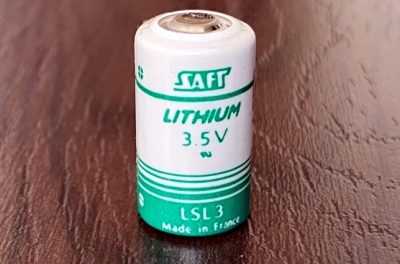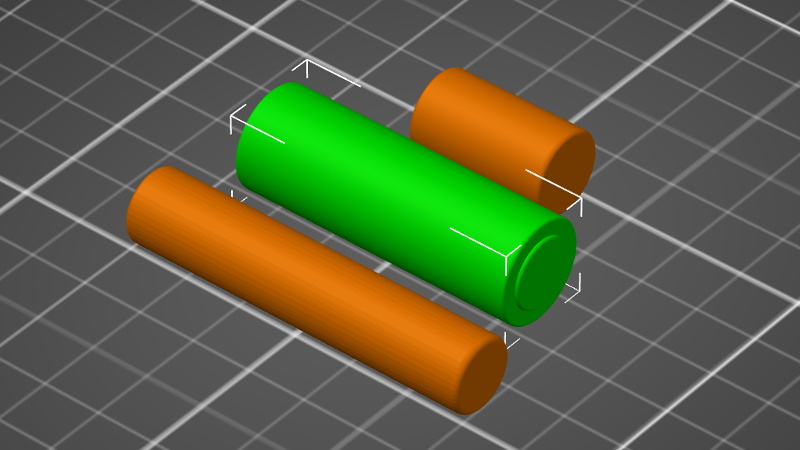The times they are a-changin’. It used to be that no household was complete without a drawer filled with an assortment of different sizes and types of batteries, but today more and more of our gadgets are using integrated rechargeable cells. Whether or not that’s necessarily an improvement is probably up for debate, but the fact of the matter is that some of these old batteries are becoming harder to find as time goes on.
Which is why [Stephen Arsenault] wants to preserve as many of them as possible. Not in some kind of physical battery museum (though that does sound like the sort of place we’d like to visit), but digitally in the form of 3D models and spec sheets. The idea being that if you find yourself in need of an oddball, say the PRAM battery for a Macintosh SE/30, you could devise your own stand-in with a printed shell.
 The rather brilliantly named Battery Backups project currently takes the form of a Thingiverse Group, which allows other alkaline aficionados to submit their own digitized cells. The cells that [Stephen] has modeled so far include not only the STL files for 3D printing, but the CAD source files in several different flavors so you can import them into your tool of choice.
The rather brilliantly named Battery Backups project currently takes the form of a Thingiverse Group, which allows other alkaline aficionados to submit their own digitized cells. The cells that [Stephen] has modeled so far include not only the STL files for 3D printing, but the CAD source files in several different flavors so you can import them into your tool of choice.
Like the efforts to digitally preserve vintage input devices, it’s not immediately clear how many others out there are willing to spend their afternoons modeling up antiquated batteries. But then again, we’ve long since learned not to underestimate the obscure interests of the hacker community.















Good idea, this could be useful for people into old radios as well, like where the hell do I get a B battery? (I know there out there but what about in 20 years?(
Yea, I have been trying to find a reasonable source of Number 6 dry cells for a while. Energizer says they have them but when you contact the New Zealand agents they have no idea what you are talking about even though you give them the code.
They were commonly used as ignition battries in old cars as well as battries in really old telephone systems.
I ended up 3D printing a casing then using a couple of D cells inside but it would have been awesome to find a source that was not going to charge $60 odd dollard per cell.
Seems clock people have the same problem.
https://www.kensclockclinic.com/our-no-6-batteries/
45 volt B Batteries, can be approximated by connecting five 9 volt batteries (or E cells as they are called) in series. But there is definitely something nice about having the right physical form factor.
Some agree with you.
https://www.batterymart.com/p-eveready-455-industrial-battery.html
This is even more crazy. 550mAH battery for $32! It’s not even rechargeable. I guess the 45v is harder to hit, but $30 consumables are no fun!
And 9 volt batteries are just six 1.5 batteries connected in series.
Are you referring to the “B” sized battery listed on this page? If you would like I can make a 3D model for printing.
https://en.wikipedia.org/wiki/List_of_battery_sizes
No, he is referring to B radio batteries.
In this section: https://en.wikipedia.org/wiki/Battery_(vacuum_tube)#B_battery
It’s unbelievable that modern devices have done away with replacable batteries.
Why is there no equivalent of the committees that do USB, to give us a safe, swappable, and standardized line of batteries, with modern lithium chemistries like LTO, short circuit resistant connectors, and maybe optional data lines?
All we have is 18650, which companies don’t seem to trust consumers with, and a whole bunch of stuff that shares a form factor with Alkaline.
Power tools have converged to a few lines of stuff using one battery, everything else…. you throw away when the battery dies??
> 18650, which companies don’t seem to trust consumers with
You hit the proverbial nail on the head here. Shorting an alkaline cell or overcharging a NiMH will kill it, puncturing either will make a mess at the worst. Doing any of the above to a lithium cell can result in a visit from the fire department or to the emergency room. Thus you need protection circuitry in every cell, which adds to the cost.
Design that protection circuitry to be re-usable when the battery is recycled.
Make the price of the cell low but tack on a deposit. If you don’t recycle it you don’t get your deposit back.
Of course the “It’s my right to just throw my trash on the ground” crowd will complain just like they do about pop cans in states w/ deposits on those but it’s about time we stop giving those people their way.
Recycling is the least of the worries. Burning down people’s houses when they mis-treat (read: throw it in the junk drawer or the bottom of a toy box like a regular AA) the cell is more the problem.
Anyway, the batteries have gotten good enough at this point that they’re frequently the longest lasting part of the device. And people with enough knowledge to handle the cells safely can replace them even in devices where they’re “non replaceable”.
I don’t think we should have any problem at all with assuming professional replacement of a dangerous part that lasts many years of service. Especially when a little bit of knowledge and effort puts things squarely back in DIY territory.
What is essentially a battery holder with the terminals moved with a little capacitor for delivering slightly more oomph for $60! I need to get into a niche market.
This was supposed to be in response to the No.6 dry cell link. Comments are kind of broken lately.
If you really think about it though, you’re talking hours of work, several dollars in materials, and a few more dollars to package and ship, to be in a niche market…. you’d work hard and be rewarded as a hundredaire!
$60 seems pretty fair to me. Probably they’re only charging that little because it’s a labor of love.
My father told me of a battery size designated “BC”, because it was the “size of a beer can”.
I can’t find any reference to this size. I’m starting to think he was making it up.
Anyone ever hear of it here?
Not by name, no, but a standard 6V rectangular battery (115mm x 68mm x 68mm) is quite close to the dimensions of a standard 12 oz soda can (123mm x 66mm dia)
Thanks Tom! I’ve previously published an Instructable which demonstrates how shells can be used as replacement batteries (link below). It’s greatly appreciated if anyone is interested in producing models of their obscure batteries or providing physical batteries for modeling.
https://www.instructables.com/LSL3-Battery-Replacement/
Nice instructable.
Why doesn’t someone in that effort write a good OpenSCAD program into which battery dimensional specs are input from a user contributed table of them to create STLs for any battery using one program?
The models on Battery Backups are dimensioned from physical batteries. I’ve found the dimensions for batteries listed online are not always reliable.
Never the less, it’s a nice idea and could work for many of the battery types!